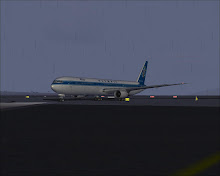The revolutionary Boeing Model 247, developed in
1933, was an all-metal, twin-engine airplane and the first modern passenger
airliner. Considered the first such aircraft to fully
incorporate advances such as all-metal, semi-monocoque construction, a fully cantilevered wing and retractable
landing gear. Other advanced features included a gyro panel for instrument
flying, an autopilot, pneumatically operated de-icing equipment, a
variable-pitch propeller and retractable landing gear.
the 247 was capable of crossing the United States
from east to west eight hours faster than their predecessors, such as the Ford
Trimotor and Curtis Condor. Entering service on May 22, 1933, a Boeing Air
Transport 247D set a cross-country record pace of 19½ hours with seven stops on
its San Francisco and New York inaugural flight. Flying with 189 mph its
trip was seven and a half hours shorter than that made
by any previous airliners.
The Boeing 247 introduces reliability, safety and
comfort in air travel and together with DC-2
aviation entered
the age of speed. The Boeing
design had been the first to enter series production, the 247 proved to have
some serious design deficiencies. Air carriers considered its limited capacity
a drawback since it only carried 10 passengers, in five rows with a seat on
each side of the aisle, as well as a flight attendant.
The 247s remained in airline service until World
War II
| First flight: | Feb. 8, 1933 |
|---|---|
| Model number: | 247 |
| Classification: | Commercial transport |
| Span: | 74 feet |
| Length: | 51 feet 7 inches |
| Gross weight: | 13,650 pounds |
| Top speed: | 200 mph |
| Cruising speed: | 189 mph |
| Range: | 745 miles |
| Ceiling: | 25,400 feet |
| Power: | Two 500-horsepower P&W Wasp engines |
| Accommodation: | 3 crew, 10 passengers, 400 pounds of mail |




No comments:
Post a Comment